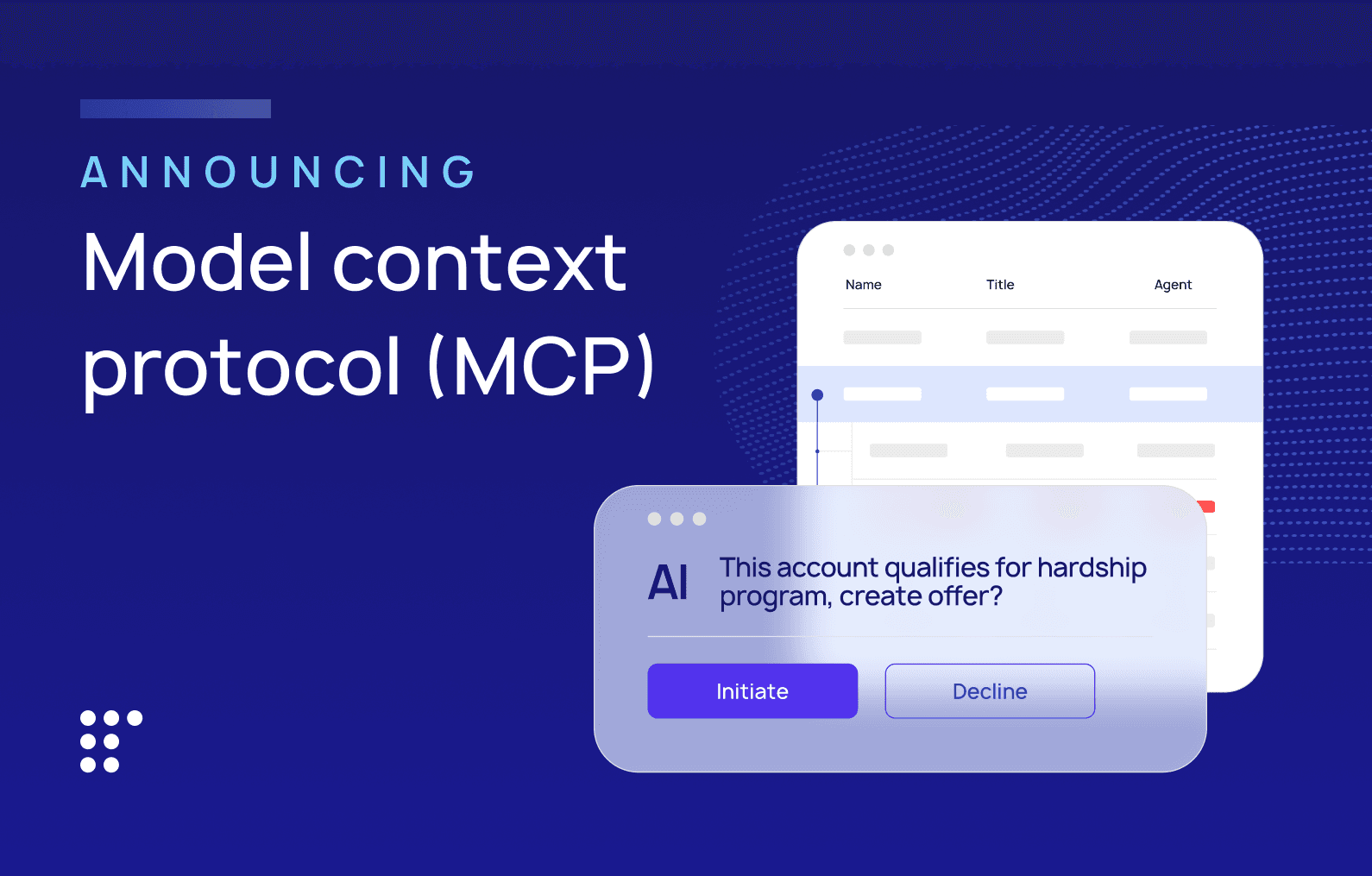The top 5 most effective lending tools for modern credit providers
We will surprise no one with the claim that the credit and lending landscape has transformed dramatically over the past few decades. What may have once required armies of underwriters, reams of paper, and weeks of processing time can now be accomplished in minutes with the right tech stack.
And yet, it remains just as obvious that there is room yet to grow. Many credit providers still struggle with fragmented systems, manual processes, and the operational inefficiencies that come with cobbling together disparate tools or building on top of legacy systems that were first designed in the Carter administration.
Ultimately, the decision often comes down to a single question: Is it more costly to invest in better tools, or to keep operating on an underperforming system? And once you’ve made that decision, how do you separate truly effective tools from expensive distractions?
What makes a lending tool effective in 2025?
Before diving into specific tools, let’s establish some common characteristics for best-in-class credit technology:
- Seamless integration. Standalone solutions create data silos, fragmenting your operation or requiring unwieldy manual processes to bridge the gap. Effective tools must integrate smoothly with existing systems and data sources, where processes across multiple tools behave like a single, cohesive system.
- Real-time processing and visibility. Just like your customers are growing to expect instant decisions or responses, you should expect real-time data from your system. Tools that rely on batch processing or overnight updates simply can't compete in today's market.
- Compliance as the default. Between the seismic shifts we’ve seen at the CFPB and the new crop of state regulations that have rushed to fill the gap, you need adaptive compliance processes embedded directly into workflows rather than treated as an afterthought.
- Scalability without complexity. As your portfolio volume grows, effective tools need to scale without requiring additional manual intervention or creating operational bottlenecks.
- User experience focus. Both borrower-facing and internal tools must prioritize intuitive design. Even shaving off a single click from a process can save countless hours over the long run.
With these criteria in mind, let's look at the most effective categories of lending tools that modern credit providers lenders are using.
1. Modern Loan Origination Systems (LOS)
What it does: Automating the start of the loan lifecycle
A modern loan origination system (LOS) serves as the digital front door for your operation, handling everything from initial application capture to final credit approvals. While legacy systems may require manual data entry or document handling, more modern LOS platforms automate the entire origination workflow.
Capturing basic borrower information through an application, a modern LOS will automatically pull credit reports and third-party data data, apply configurable underwriting rules, and route exceptions to human reviewers only when necessary.
And when integrated with the rest of your tech stack, modern loan origination systems go beyond simple application processing. They create a comprehensive borrower profile that follows the loan throughout its lifecycle, ensuring that critical origination data remains accessible for servicing, collections, and future lending decisions.
Why it's effective: Improving the borrower experience and curtailing risk
An LOS needs to strike a balance between two competing goals: Approve as many borrowers as possible as quickly as possible, and don’t approve anyone beyond our risk appetite.
Speed without predictive accuracy is worthless. Modern origination systems improve both by applying consistent underwriting criteria and reducing human error. Automated decisioning handles routine approvals in seconds, while sophisticated rules engines flag any applications that require human review. This combination ensures that speed doesn't come at the expense of credit quality.
Improvements to borrower experience are equally important. Instead of filling out multi-page forms and manually entering their personal data, borrowers can submit a few basic identifiers and then track their application status in real-time, receiving instant updates throughout the process.
2. Comprehensive Loan Management Software (LMS)
What it does: Creating a single source of truth for servicing
A comprehensive loan management system serves as the central nervous system for your credit or lending operation. It maintains the complete record of every loan from origination through payoff, including payment history, balance calculations, escrow management, and borrower communications.
While basic ledgers or headless cores might leave substantial servicing tasks to your team and developers, modern LMS platforms provide tools to keep borrowers satisfied, engaged, and repaying. They handle complex account structures, drive repayment, manage account and customer updates, process payments, and maintain detailed audit trails for regulatory compliance.
Modern LMS platforms also allow you to consolidate from multiple systems down to one. Rather than maintaining separate software for different account types or functions, modern platforms handle everything in one integrated environment, from credit cards and personal loans to BNPL, crypto loans, or your own hybrid programs.
Why it's effective: Flexibility and scalability
Legacy core systems often force lenders into rigid workflows that can't adapt to changing business needs. Modern LMS platforms provide the flexibility to launch new credit products and modify your existing programs in flight, adapting to market changes without requiring back-end coding or lengthy implementation timelines.
One of LoanPro’s clients, for instance, recently launched a net new product in just 42 days. The same changes would have taken their previous core system six months and significant IT resources to implement and maintain.
Scalability becomes critical as portfolio volumes grow. Comprehensive loan servicing platforms handle increased transaction volumes without requiring proportional increases in staff. Automated processing (covered in greater depth below), exception-based workflows, and intelligent routing all work together to ensure that growth doesn't create operational bottlenecks.
3. Automated servicing & collections tools
What it does: Streamlining routine tasks and managing delinquency
Automated servicing and collections tools handle the day-to-day portfolio management, limiting or even eliminating the need for human intervention. These systems process payments, apply funds according to predefined rules, generate and send statements, manage escrow accounts, and initiate collections activities.
The automation extends beyond basic payment processing. Modern tools handle complex scenarios like partial payments, payment reversals, fee assessments, and interest rate adjustments. They can automatically generate and send borrower communications, update credit bureau reports, and escalate delinquent accounts through progressive collections workflows.
Collections automation is particularly powerful. Instead of waiting for human collectors to identify delinquent accounts and initiate contact, automated systems begin collections activities immediately when payments become past due. This might include sending emails, text messages, or letters, making outbound calls, or updating account status based on borrower responses.
Why it's effective: Driving operational efficiency and reducing default rates
The operational efficiency gains from servicing automation are substantial. Tasks that previously required dedicated staff members now happen automatically, freeing up human resources for higher-value activities like managing borrower relationships and resolving complex problems. It’s not simply replacing humans with an automated system, but instead empowering human agents to focus on their areas where their talents drive the most impact.
One LoanPro client, for example, used configurable automation tools and our API to streamline and automate every aspect of their servicing. Their COO estimated that performing those processes manually would have required an operations team 10x their current size.
Early intervention is key to successful collections. Automated systems can initiate collections activities the same day a payment is missed, while human-driven processes might take days or weeks. This early contact significantly improves the likelihood of payment and reduces the severity of delinquency. The results speak for themselves: Credit providers using the automated servicing and collections tools in LoanPro saw an average 38% decrease in credit losses after just a year.
4. Integrated payment processing solutions
What it does: Handling the complete payment lifecycle
Payment processors manage the actual movement of money from borrowers’ accounts to yours. They handle the technical complexity of connecting with various payment networks and financial institutions, making your collections smoother and more reliable.
Modern payment systems may also include features like dispute management, chargeback processing, and automatic retries for failed transactions, while also maintaining security and compliance standards. PCI compliance is standard across the industry, but some processors offer additional tools for encryption, auditing, and fraud detection, identifying suspicious payment patterns and flagging potentially fraudulent transactions.
Why it's effective: Ensuring compliance and payment flexibility
If you want your borrowers to pay you back, it behooves you to make payments easy for them. Whether that's through mobile apps, online portals, phone systems, or even cash payments, a strong payment strategy requires you to match the methods your customers demand while maintaining consistent processing and reporting. The compliance benefits are equally important. Integrated solutions handle compliance requirements automatically, reducing risk and eliminating the need for separate compliance management.
Processing efficiency improves significantly with integrated solutions. Instead of manually reconciling payments from multiple processors and updating loan systems separately, everything happens automatically. This reduces errors, speeds up posting times, and provides borrowers with immediate balance updates.
5. Built-in compliance and reporting tools
What it does: Embedding regulatory adherence into workflows
Built-in compliance and reporting tools weave regulatory requirements directly into your credit and lending workflows rather than treating compliance as a separate process. These systems automatically generate required disclosures, maintain audit trails, and actively prevent regulatory violations.
On many systems, compliance comes as something of an afterthought, with tools or processes bolted on after the fact. More effective tools embed compliance checks into your core processes, making compliance the default. When a payment is processed, compliance rules are automatically applied. When an account is modified, required disclosures are generated automatically.
Reports and audits can also be the default, rather than a manual process. Modern tools provide the analytics and insights needed to identify trends, monitor portfolio performance, and make data-driven decisions. They can generate custom reports, provide real-time dashboards, and alert management to potential issues before they become problems.
Why it's effective: Reducing risk and simplifying audits
Regulatory risk is one of the biggest challenges facing modern lenders. The cost of compliance violations extends far beyond monetary penalties, potentially including reputational damage, regulatory restrictions, and loss of business relationships. Built-in compliance tools significantly reduce this risk by ensuring that regulatory requirements are met consistently and automatically.
Audit preparation becomes dramatically simpler when compliance is embedded in workflows. Instead of scrambling to gather documentation and reconstruct transactions, auditors can access complete, real-time compliance records directly from the system with just a few clicks. This reduces audit costs, minimizing both compliance risk and disruptions to your operations.
The consistency of automated compliance is particularly valuable. Human-driven compliance processes are subject to errors, omissions, and inconsistent application. Automated systems apply rules uniformly, ensuring that every transaction meets regulatory requirements regardless of volume or complexity.
The power of a unified platform over disjointed tools
While each of these tool categories delivers significant value individually, their true power emerges when they work together as part of a unified, cohesive platform.
Legacy systems and weaker new market entrants often force lenders into a fragmented approach: data is manually transferred between systems, borrower information exists in multiple places, and reporting requires pulling data from various sources and reconciling differences.
But if you’re using a modern platform that acts as a single source of truth, the problems of that fragment approach vanish. When a borrower makes a payment, the transaction updates the loan balance, triggers any necessary collections workflows, generates compliance reports, and sends payment receipts, all in real-time.
This integration enables capabilities that simply aren't possible with disjointed tools. Real-time portfolio analytics, automated cross-selling opportunities, and comprehensive borrower relationship management become standard features rather than expensive customizations.
The operational efficiency gains compound when systems work together. Instead of managing multiple vendor relationships, training staff on different interfaces, and maintaining separate data sources, lenders can focus on growing their business and serving their borrowers.
Upgrade your credit and lending operations today
The financing industry will continue evolving rapidly, driven by changing borrower expectations, regulatory requirements, and competitive pressures. Creditors who invest in effective, integrated tools today will be positioned to thrive in this environment, while those clinging to legacy systems will struggle to keep pace.
The five tool categories outlined above represent the foundation of modern credit and lending operations. Whether you're looking to improve origination speed, enhance servicing efficiency, or strengthen compliance management, the right technology platform can deliver transformative results.
Ready to see how these tools can transform your operation? Schedule a demo to see a modern credit platform in action, and talk with our team about optimizing your current processes.
The future of finance belongs to the credit providers that embrace the best tools. The question isn't so much whether you need these tools, but whether you'll implement them before your competition does.



